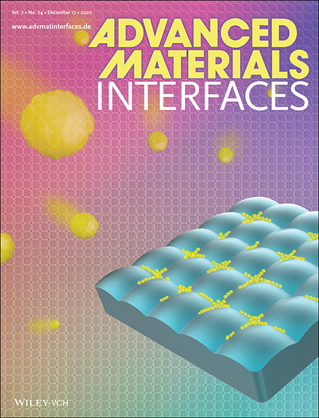- About Ajou
- Admission
- Academics
- Research
-
International
International
- Campus Life
-
News and Event
News and Event
-
AUT
AUT
Major Research Result
NEW A New Wrinkle in Smart Technology: Scientists Control Crease Formation on Polymer Surface
- 2021-02-10
- 3630
Scientists grow wrinkle patterns on polymer surfaces in a spontaneous and reversible manner, spurring advances in smart soft matter technology
Natural creases on animal skin have inspired the engineering of such patterns on polymers for the design of “smart surfaces.” However, the engineered patterns are often permanent, limiting their control. In their latest study, scientists from Ajou University, Korea, have come up with a way to form wrinkles on hydrogel surfaces in a controlled, reversible fashion, opening doors to innovations in soft-matter-based smart technology.

Fabrication of polymer films with long-range wrinkle patterns can aid in the development of smart surfaces with applications in dry adhesion, sensing, and smart windows. A new study in Advanced Materials Interfaces reveals a way to control wrinkle formation in soft matter.
Photo Courtesy: Advanced Materials Interfaces, Wiley Online Library
Sometimes, simply looking at nature can inspire clever innovations in technology. In fact, an entire field of research, called “biomimetics,” is based on the idea of emulating nature to engineer novel structures like “smart surfaces,” which can change their shape or property in response to changes in the ambient environment (temperature, humidity, light intensity, pH, etc.)
An inspiration for these smart surfaces comes from the crinkles or crease patterns found on the skin of animals. “The wrinkles on our skin are designed for practical purposes such as gripping objects without slipping or facilitating heat dissipation through a large surface area. In addition, they can be used to control alignment of small particles on a material surface without needing a complex chemical or physical interaction,” explains Dr. Tae Soup Shim from Ajou University, Korea, whose research group focuses on the design of smart surface materials.
While such wrinkle patterns have been successfully engineered in polymeric materials, their precise control has been challenging due to the fact that such structures are often permanent.
Now, in a new study published in Advanced Materials Interfaces, Dr. Shim and his colleagues found a way to format uniform wrinkle structures. In their design, they successfully formed crease patterns on a hydrogel (a crosslinking chain of “water-loving” polymers) film from its surface deformations, in a uniform manner. Dr. Shim says, “Through our study, we were able to control the wrinkle formation mechanism step by step, for the first time.”
In their strategy, the scientists used a technique called “reaction-diffusion-mediated photopolymerization” (RDP) (essentially a UV-light-mediated polymerization reaction) to fabricate a hydrogel film called p(HEMA-co-AA) film, and then caused it to deform, giving rise to hill-and-valley-type structures. Depending on the properties of the UV light used, the structures could be either isotropic (with the same properties in all directions) or anisotropic (properties changing with direction). The scientists found that the anisotropic structures were the key to controlling the wrinkle formation process, and thus, they used a UV source with an anisotropic intensity profile to generate anisotropic hills and valleys. Then, the scientists increased the pH of the film, which caused it to swell and form the crease patterns. Since the swelling process is reversible, scientists could repeat the creasing and flattening of the film simply by changing the pH!
Further, to demonstrate the aligning behavior of particles due to the crease patterns, scientists made the film interact with “free-moving” yeast cells. They noticed that as the creases developed, not only did the yeast cells align themselves along the crease patterns but also reproduced along them, showing guided cell growth. The p(HEMA-co-AA) film could, therefore, potentially serve as a suitable platform for studying other direction-specific cells and biomolecules, such as neurons and DNA.
With such promising results, scientists are excited about the potential applications of wrinkle structures in real life. “We expect that the strategy implemented in our study will make the fabrication of polymer materials with a uniform wrinkle structure much easier. These polymers can then be used to design smart surface materials that can find applications in smart adhesion technology, gas sensing, and smart windows,” comments Prof. Shim.
This study, indeed, adds a new wrinkle in the development of smart materials!
Reference
Authors: | Mina Kim1, Kwon-Young Choi2, Ju Min Kim1,3 and Tae Soup Shim1,3 |
Title of original paper: | Stepwise Evolution of Crease Patterns on Stimuli-Responsive Hydrogels for the Production of Long-Range Ordered Structures |
Journal: | Advanced Materials Interfaces |
DOI: | 10.1002/admi.202001551 |
Affiliations: | 1Department of Energy Systems Research, Ajou University 2Department of Environmental Engineering, Ajou University 3Department of Chemical Engineering, Ajou University |
*Corresponding author’s email: tsshim@ajou.ac.kr
About Ajou University
Founded in 1973, Ajou University has quickly grown to become one of the top universities in the Republic of Korea. With over 15,000 students and 50 research centers in diverse fields, Ajou University partakes in the largest national research and graduate education project funded by the Korean Ministry of Education. In line with its recently reformed vision, Ajou University’s goal is to change society by connecting minds and carrying out high-impact research to improve the welfare of people in and outside Korea.
Website: https://www.ajou.ac.kr/en/index.do
About the author
Dr. Tae Soup Shim is an Associate Professor at the Departments of Chemical Engineering and Energy Systems Research, Ajou University, Korea. He received a PhD degree in Chemical and Biomolecular Engineering from KAIST, Korea. Following this, he worked as a postdoctoral researcher at Department of Chemical and Biomolecular Engineering, University of Pennsylvania, USA. His major research interests include colloidal self-assembly, stimuli-responsive materials, interfacial phenomena, and biomimetics. Currently, his group has been focusing on designing micro-/nanostructures based on soft matter for the development of shape-transformable soft actuators, flexible electronic devices, and smart surface materials.
